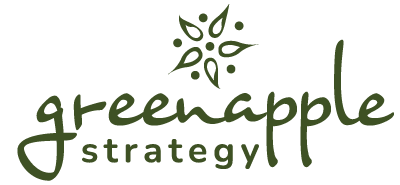If you’ve worked in marketing for more than five minutes, you know the drill: Someone from leadership walks in with an idea they’re really excited about. “Let’s launch a new campaign next month. We can call it X!”
You smile and nod while you’re silently wondering, “How do I fit this in with everything else on my plate? What does success even look like for this idea?”
Sound familiar? You’re not alone. One of the biggest challenges in marketing is staying focused on the plan while also staying open to great ideas that pop up along the way.
At Green Apple, we’ve helped companies across a wide range of industries take good ideas and turn them into great campaigns. Along the way, we’ve learned a few lessons. We believe that the secret sauce for marketing isn’t just about the initial spark of creativity; it’s about the thoughtful process of developing that spark into a well-defined campaign concept that’s primed to deliver real, measurable results.
In this post, we’re sharing a handful of best practices to help you take that next campaign concept and shape it into something creative, effective, and aligned with your business goals.
Designing a Marketing Campaign That Delivers Results
1. Start With the Big Picture
Before you even start thinking about taglines or visuals, take a step back. Why does this campaign need to exist? How does it ladder up to your overarching business objectives? A successful campaign isn’t a standalone project; it’s a strategic piece of the puzzle that contributes to your larger goals. Those goals could be increasing brand awareness, generating qualified leads, or nurturing customer relationships. By grounding your campaign in the “why,” you’ll ensure it resonates authentically with your audience and makes strategic sense for your business.
2. Align the Campaign With Your Brand Story
Your brand story is the heart and soul of your business. Every marketing campaign should be a chapter in that ongoing narrative. When your campaigns align with your brand story, they feel more genuine, build stronger connections with your audience, and reinforce your core values. Think about how you can weave your brand’s unique voice, values, and mission into your campaign messaging and visuals. This consistency creates a cohesive brand experience that resonates on a deeper level than a standalone promotion.
3. Craft Messaging That Speaks Their Language
High-level messaging isn’t about catchy slogans; it’s about understanding your ideal customer profiles inside and out. Your messaging should speak to their pain points and their aspirations and should be delivered in their preferred communication styles. Once you have a firm grasp on your audience, you can craft campaign messaging that speaks directly to their needs and resonates with their challenges. After the messaging is solidified, you can strategically choose the channels you’ll use to get the word out. Where does your target audience spend their time? Are they active on LinkedIn? Do they prefer email updates? Choosing the right channels ensures your message reaches the right people, maximizing your impact.
4. Embrace a Process-Driven Approach
That brilliant campaign concept needs to be brought to life effectively and efficiently. This requires a process-oriented approach to creative execution. Will you be relying on your in-house team, bringing in an experienced marketing agency, or exploring AI-powered tools to streamline content creation? Develop a clear plan that outlines responsibilities, timelines, and approval processes. A well-defined workflow minimizes bottlenecks, builds brand consistency, and keeps your campaign on track, ultimately leading to a smoother and more successful launch.
5. Understand the Power of Project Management
Everyone loves the thrill of brainstorming big ideas, but campaigns that truly make an impact require meticulous attention to detail in the day-to-day execution. This is where project management becomes your best friend. Implementing tools and processes to track tasks, manage deadlines, and ensure clear communication within your team is crucial. From scheduling social media posts to coordinating email sends and monitoring campaign performance, conquering the “daily grind” means that no crucial detail is overlooked and your campaign stays on course to deliver results.
6. Build Multi-Touchpoint Momentum
Think of your audience as busy individuals with a lot vying for their attention. Rarely does a single message cut through the noise. Instead of relying on a one-and-done approach, strategically build in multiple touchpoints across different channels over a reasonable timeframe. This consistent reinforcement of your message, whether through a series of emails, complementary social media posts, or website banners, increases brand recall and gives your campaign the time it needs to truly resonate and drive action.
7. Repurpose Content Creatively
Embrace the power of repurposing content to maximize your investment. That insightful webinar you hosted? Turn key segments into short, engaging video clips for social media. That in-depth blog post? Extract compelling quotes for shareable graphics or create a concise infographic. By creatively reimagining your existing content in different formats, you can reach new audiences and reinforce your message across multiple touchpoints without significantly increasing your workload.
Do You Need to Take All These Steps? Determine What’s Essential
Before you dive headfirst into design software or schedule that first social media post, it’s important to recognize that not every campaign requires the same level of heavy lifting. Some initiatives are large-scale, strategic endeavors that demand significant intentionality, while others are more ad hoc or time sensitive. What’s important is being proactive rather than reactive.
So, how do you determine which best practices are essential for your specific campaign? Here are a few diagnostic questions to consider:
- What are the primary goals of this campaign? Are they focused on brand awareness, lead generation, sales enablement, or something else?
- What is the intended reach and duration of this campaign? Is it a short-term promotion or a longer-term initiative?
- What are the budget and team resources allocated to this campaign?
- How critical is it for this campaign to align with our overarching brand strategy and messaging?
- What level of measurability and reporting is required for this campaign’s success?
- What is the potential impact of this campaign on other areas of our business, such as sales and customer service?
- What target audience segments are we trying to reach?
Answering these questions will help you gauge the scope of your campaign and determine which best practices will be most critical for its success.
Find Your Marketing Sweet Spot
Developing marketing campaigns that truly drive results isn’t about chasing fleeting trends or executing random acts of creativity. It’s about a thoughtful, strategic process that starts with understanding your “why,” aligns with your brand story, resonates with your audience, and is executed with precision.
Ready to gain a deeper understanding of our strategic planning process and get an inside look at how Green Apple Strategy develops impactful marketing campaigns for our clients? Let us share our expertise and help you turn your creative ideas into tangible results.


